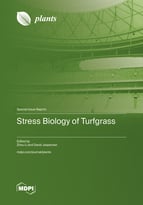Stress Biology of Turfgrass
A special issue of Plants (ISSN 2223-7747). This special issue belongs to the section "Plant Response to Abiotic Stress and Climate Change".
Deadline for manuscript submissions: closed (31 August 2023) | Viewed by 23617
Special Issue Editors
Interests: turfgrass or ground-cover plant in response to abiotic stress such as heat stress, drought, or ionic stress (salt, aluminum, and cadmium); turf management; stress-defensive gene and protein; omics study; signal transduction; gene function; phytohormone; plant growth regulator
Interests: physiological and molecular responses to abiotic stresses in turfgrasses; heat stress; drought stress; salinity stress; flooding tolerance; low-light/shade stress
Special Issue Information
Dear Colleagues,
Turfgrass is widely used for landscaping, sports turf, and ecological restoration. However, environmental stresses including abiotic and biotic stresses decrease turf quality and also increase the costs of turf maintenance. This Special Issue will be focused on physiological, metabolic, and molecular mechanisms of turfgrasses in response to abiotic stresses such as drought, heat, cold, or ionic stress (salt, aluminum, and cadmium), as well as biotic stresses including insects, parasites, viruses, fungi, or bacteria. Transgenic technology and omics studies based on ionomics, metabolomics, proteomics, or transcriptomics are important approaches to reveal adaptive response to abiotic and biotic stresses in turfgrass species. In addition, improved knowledge of turf maintenance and management in the field during environmental stress associated with new technologies and mechanisms will be included.
The current research topic aims to collect research and review articles involved in, but not being limited to:
- Antioxidant defense systems and reactive oxygen species in turfgrass in response to abiotic and biotic stress;
- Effects of phytohormones and plant growth regulators in turfgrass exposed to stress;
- Roles of secondary metabolites in turfgrass under a stress condition;
- Signal transduction and metabolic pathways affected by stress in turfgrass;
- Key genes and proteins associated with stress tolerance in turfgrass, including transcriptomic and proteomic studies.
Prof. Dr. Zhou Li
Dr. David Jespersen
Guest Editors
Manuscript Submission Information
Manuscripts should be submitted online at www.mdpi.com by registering and logging in to this website. Once you are registered, click here to go to the submission form. Manuscripts can be submitted until the deadline. All submissions that pass pre-check are peer-reviewed. Accepted papers will be published continuously in the journal (as soon as accepted) and will be listed together on the special issue website. Research articles, review articles as well as short communications are invited. For planned papers, a title and short abstract (about 100 words) can be sent to the Editorial Office for announcement on this website.
Submitted manuscripts should not have been published previously, nor be under consideration for publication elsewhere (except conference proceedings papers). All manuscripts are thoroughly refereed through a single-blind peer-review process. A guide for authors and other relevant information for submission of manuscripts is available on the Instructions for Authors page. Plants is an international peer-reviewed open access semimonthly journal published by MDPI.
Please visit the Instructions for Authors page before submitting a manuscript. The Article Processing Charge (APC) for publication in this open access journal is 2700 CHF (Swiss Francs). Submitted papers should be well formatted and use good English. Authors may use MDPI's English editing service prior to publication or during author revisions.
Keywords
- abiotic and biotic stresses
- stress physiology
- defense mechanism
- antioxidant
- metabolic regulation
- water homeostasis
- photosynthesis
- omics
- stress-defensive genes and proteins







